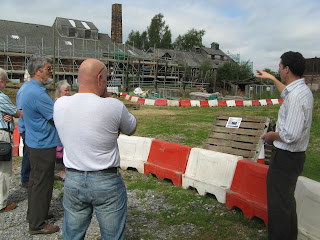The scaffold is
complete…

Completing the scaffold over the
summer months was a long and difficult process given the condition of the
buildings. Seven buildings in total within the historic core had to be propped:
both Pan Houses 3 and 4, Stove Houses 2, 3 and 4, the Link Block and the
Packing Area.

The scaffold of each historic
building had to be individually designed in order to take the unique weights
and stresses. The scaffold secures the walls and floors and takes the weight
from existing structure of cast iron columns, iron girders, wooden posts and
beams. The scaffold not only props the building but allows access to the upper
working areas of the site: the roofs, the roof beams and the upper floors.
Without the scaffold the working environment would be too dangerous.
With the scaffold in place the
future of the building is secure and many of the initial restoration tasks can
now be undertaken.
Meet the team
The enabling work that stabilised the building was undertaken by Wates Construction and they have now been contracted to undertake the main restoration work. They will be ably assisted by William Anelay who undertook the enabling works in 2009 that saw the dismantling of many of the partially collapsed structures.
 The restoration process
The restoration process
In order to secure the structural condition of the buildings
the internal and walls of the building will be entirely rebuilt. In places
these had partly collapsed as they had been built on metal plates and girders
that had disintegrated due to the corrosive effects of salt reacting with the
metal.
In addition external walls will be dismantled and rebuilt on
more secure foundations.

This will involve brick by brick dismantling of the wall and
excavation down to foundation level before rebuilding.
Grouting the Brine
Shaft and Boreholes
The former brine shaft that allowed brine to be extracted
from the brine streams flowing beneath the site has to be grouted in order to
make it safe. Although the location of the brine shaft was known from historic
maps and plans it was necessary to locate it on the ground.
 Completing the scaffold over the
summer months was a long and difficult process given the condition of the
buildings. Seven buildings in total within the historic core had to be propped:
both Pan Houses 3 and 4, Stove Houses 2, 3 and 4, the Link Block and the
Packing Area.
Completing the scaffold over the
summer months was a long and difficult process given the condition of the
buildings. Seven buildings in total within the historic core had to be propped:
both Pan Houses 3 and 4, Stove Houses 2, 3 and 4, the Link Block and the
Packing Area. The scaffold of each historic
building had to be individually designed in order to take the unique weights
and stresses. The scaffold secures the walls and floors and takes the weight
from existing structure of cast iron columns, iron girders, wooden posts and
beams. The scaffold not only props the building but allows access to the upper
working areas of the site: the roofs, the roof beams and the upper floors.
Without the scaffold the working environment would be too dangerous.
The scaffold of each historic
building had to be individually designed in order to take the unique weights
and stresses. The scaffold secures the walls and floors and takes the weight
from existing structure of cast iron columns, iron girders, wooden posts and
beams. The scaffold not only props the building but allows access to the upper
working areas of the site: the roofs, the roof beams and the upper floors.
Without the scaffold the working environment would be too dangerous. This will involve brick by brick dismantling of the wall and
excavation down to foundation level before rebuilding.
This will involve brick by brick dismantling of the wall and
excavation down to foundation level before rebuilding.



